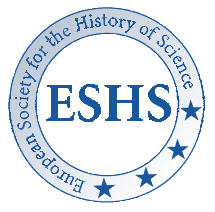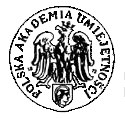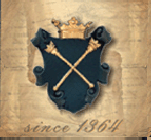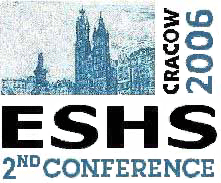Last modification: 31 August 2006
Online Book of Abstracts - A Thematic List:
SESSIONS / SYMPOSIA
Edited by Michal Kokowski
http://www.cyfronet.pl/~n1kokows/home.html
n1kokows@cyf-kr.edu.pl
Symposium R-4.
NICHOLAS COPERNICUS IN FOCUS
ORGANIZER AND CHAIRMAN OF THE SYMPOSIUM:
Michal KOKOWSKI (Krakow, Poland)
www.cyfronet.pl/~n1kokows/home.html
n1kokows@cyf-kr.edu.pl
R-4.
Bibliografia Kopernikowska T. 1-3 (Copernican Bibliography Vol. 1-3)
Henryk BARANOWSKI (Torun, Poland)
Pracownia_pomorzoznawcza@bu.uni.torun.pl
Three scientists: W. Bruchnalski (1924), F. Kubach (1943) and L. Brożek (1949) worked and prepared documentation (e.g. bibliographies) concerning the broad range of scientific disciplines, not only astronomy, Nicolaus Copernicus was involved in. Those bibliographies are not easily available, besides they are not completed, based on mostly Polish and German literature.
Therefore, Mr. Henryk Baranowski - a librarian from Nicolaus Copernicus University Library in Toruń - started works on writing a full bibliography of Nicolaus Copernicus, including the entirety of his activities. The bibliography was published in Warsaw in 1958, encompassing the period from 1501 to 1955, with 3750 bibliographical items in it.
In 1970 the bibliography was reprinted in New York.
At the opportunity of The Copernican Year in 1973, the next part of 'Bibliografia Kopernikowska', for the period 1972-2001 with 1207 items, was published in Warsaw too.
The Nicolaus Copernicus University Press in Torun published the third volume of this bibliography in 2003. It included years from 1972 to 2001 and had 8246 bibliographical items.
'Bibliografia Kopernikowska' is international and includes works and documents Copernicus wrote himself as well as the literature about him. It exclusively contains printings; omitting manuscripts, prints and maps (with insignificant exceptions). The subject part (Copernicus's works) of the bibliography is in a chronological order. The object part (works about Copernicus) is in a systematical order. Bibliographical descriptions include concise annotations completing the descriptions or indicating the relations with other items.
Mr. Henryk Baranowski is the author of all three parts of 'Bibliografia Kopernikowska'. Mrs. Jolanta Goławska contributed to the third part as far as technical concept of Copernican Bibliography is concerned.
R-4.
Towards a cognitive history of the Copernican Revolution
Peter BARKER (Oklahoma, USA)
barkerp@ou.edu
I have recently contributed to a book (H. Andersen, P. Barker and X. Chen, The Cognitive Structure of Scientific Revolutions (Cambridge, 2006)) that introduces techniques from cognitive science to analyze episodes in the history of science, including the Copernican Revolution. In this paper I sketch some techniques of concept representation that are relevant to appraising the astronomical systems of Ptolemy and Copernicus. I then show that the appraisal of the two systems depends crucially on whether the equant mechanism is represented in Ptolemy's conceptual structure. Including the equant makes Ptolemy's conceptual structure incommensurable with a simpler version that omits the equant. Copernicus' conceptual structure is a minor variation of this simpler, equant free, Ptolemaic structure. This representation of the conceptual structures of Ptolemaic and Copernican astronomy helps to explain why early sixteenth century advocates of Copernicus saw him as a reformer and not a revolutionary, and also why they uniformly stressed the elimination of the equant as a key feature of his work.
In earlier work ("Incommensurability and conceptual change during the Copernican Revolution," in P. Hoyningen-Huene & H. Sankey (Eds.) Incommensurability and Related Matters. "Boston Studies in the Philosophy of Science" (Boston: Kluwer, 2001) 241-273). I adopted the dynamic frame representation of concepts developed by American cognitive psychologist L. W. Barsalou. Using this representation concepts are displayed as an array of attributes and values. For example the concept CIRCULAR MOTION has attributes CENTER, RADIUS and SPEED. Using this representation, the fundamental principle of classical astronomy "All celestial motion is circular, centered on the earth and at uniform speed" may be represented as a more complex recursive frame with specific values of each attribute defining the motion of single celestial object.
In the 2006 book Andersen, Chen and I have further developed Kuhn's account of incommensurability using the frame representation of concepts. Changes that generate incommensurability are those that introduce new ranges of values, or add and delete attributes, in such a way that entities are permitted that were excluded by the previous conceptual structure. When these techniques are applied to the the historical confrontation between Ptolemaic astronomy and Copernican astronomy, in the period before the work of Galileo and Kepler, some surprising results emerge. The appraisal of the two systems depends crucially on whether the equant mechanism is represented in Ptolemy's conceptual structure. Including the equant makes Ptolemy's conceptual structure incommensurable with a simpler version that omits the equant. Copernicus' conceptual structure is a minor variation of this simpler, equant free, Ptolemaic structure. This representation of the conceptual structures of Ptolemaic a nd Copernican astronomy helps to explain why early sixteenth century advocates of Copernicus saw him as a reformer and not a revolutionary, and also why they uniformly stressed the elimination of the equant as a key feature of his work.
R-4.
Investigations on the life and extensive works of Nicolas Copernicus
Marian BISKUP (Torun, Poland)
m.biskup@neostrada.pl
Polish science has made an effort to supply documentary evidence on the full, lifetime activity of Nicolas Copernicus and it's character especially during the time when he was a canon at the Chapter of Varmia. This is the reason why the Author has published "Regesta Copernicana" ("Calendar of Copernicus' Papers"), Wroclaw 1973, that includes 520 items of Copernicus' works from the years 1448 - 1550. A wide range of reference, printed as well as the ones gathered partly in the archives and libraries of Sweden, Italy, Germany and Poland, were used whilst elaborating the work. The drew up regesta gives the signature of the source or the place of the publication which all shows the entirety of the lifetime activity of Copernicus. This is starting with the time he spent at the University of Cracow, following with the period at the Italian Universities and then since the year 1504 the time spent at the bishop's Varmia as a canon of Frombork (Frauenburg) Chapter. The register highlights his activity particularly as a trustee of the Chapter's property (years 1516 - 1519 and the year 1521) and a repeated chancellor of the Chapter, the author of several letters written on it's behalf. The register also shows the role of Copernicus in the monetary reform between Prussia and Varmia that were related with the Polish Crown, it specifies the dates of his consecutive reformative treaties. Another information derived from the register is his role as a doctor respected by the successive bishops of Varmia and as a defender of the south Varmia from military aggression of The Teutonic Order, by being in close contact with commanders of the King Zygmunt army. Furthermore, the dates of all the astronomical observations made in Frombork and Olsten, as well as the circumstances of preparing "De revolutionibus" are stated in the register.
"Regesta" is supplemented with an edition of some of the completed original works that were found during search queries and this is especially in the publication: "New materials to public activities of Nicolas Copernicus from 1512 to 1537", Warsaw 1971. Copernicus' contribution to the monetary reform of Prussia is most widely presented in the work "Acta Statuum Terrarum Prussiae Regalis" vol. VIII Varsaviae-Torun 1993 and two volumes "Protokole des Landtags von Königlich Preussen" vol. I-II Torun 2001-2005.
R-4.
Ptolemy, Copernicus, and Kepler on linear distances
André GODDU (Easton, MA USA)
agoddu@stonehill.edu
Puzzles about variations in the distances of the planets from Earth and inconsistencies about their periods of motion relative to Earth along with the assumption that the celestial spheres should be ordered according to a consistent principle led Copernicus to adopt Earth's orbital motion. Consideration of data alone does not completely explain the origin of his cosmological hypothesis, for he makes assumptions that go beyond the data.
The paper summarizes Ptolemy's assumptions and data about the ordering of the celestial bodies and their linear distances from Earth. Copernicus nowhere explains precisely how he arrived at the heliocentric theory. His explicit statements explain why he was convinced of the correctness of his cosmological assumptions, but extracting his path to heliocentrism from these statements has led to a variety of accounts. This paper explores questions about the ordering of the celestial spheres and linear distances, arguing that these considerations led Copernicus to propose Earth's orbital motion around the Sun.
Kepler, in turn, concluded that variations in distance had physical consequences for which only physical hypotheses and physical principles could provide an explanation.
This paper is part of a project on Copernicus's relation to the Aristotelian tradition and his likely education in Aristotelian logic, natural philosophy, and cosmology at the University of Kraków between 1491 and 1495.
R-4. (POSTER)
Copernicanism in Iceland
Einar H. GUDMUNDSSON (Reykjavik, Iceland)
einar@raunvis.hi.is
Eyjólfur KOLBEINS (Reykjavik, Iceland)
eyjolfur.kolbeins@torg.is
Thorsteinn VILHJALMSSON (Reykjavik, Iceland)
thv@hi.is
Like in many other countries of the European periphery, considerable time passed from the proposition of the helicentric cosmology of Copernicus until it was accepted in Iceland. The country belonged at this time to Denmark and the University of Copenhagen was in practice also the University of Iceland. Thus Copernicanism first had to make its way to Denmark and subsequently to Iceland through the hands of previous Copenhagen students returning to their country of origin.
Important sources for this two-step process consist in so-called disputations in Latin given by Icelandic students during their years of study in Copenhagen in the 17th and 18th centuries. These disputations were printed, although in small numbers, and quite a few of them have been preserved. Many of the writers later became well-known persons in Icelandic history, holding for instance leading official positions within the state administration and the church in Iceland.
Naturally, Danish astronomers in the first half of the 17th century tended to support the compromise cosmology of Tycho Brahe (1546-1601). Later people like Rasmus Bartholin (1625-1698) and Ole Römer (1644-1710) started teaching Descartes' theories at the university, thus more or less incorporating heliocentrism. The first Danish scholar to support Newton's mechanics was Jens Kraft (1720-1765) who, however, was not active at the force center of Copenhagen. Thus, it was Thomas Bugge (1740-1815) who introduced Newtonianism in the teaching of the University of Copenhagen. The fight for Newtonian ideas like action at a distance continued until the negative influence of the powerful physisicist Hans Christan Örsted (1777-1851) was finally neutralised.
All of this is clearly reflected in the history of ideas in Iceland as reported through the disputations. The story begins with several scholars of the 16th-17th century, one of whom even stayed for a while with Tycho Brahe at the island of Hven. One of the most important 17th century scholars in Iceland was bishop Brynjólfur Sveinsson (1605-1675) who is known to have owned books discussing the Copernican theory although nothing indicates that he supported it actively. Some of these bishops and officials ventured, e.g., to measure the geographical latitude of Iceland which had previously been wrongly stated, for instance in well-known maps.
The development continued in this direction up to the late 18th century when we can safely say that the Copernican revolution in Iceland was finished. This is described in further detail in the paper on which the conference poster will be based.
R-4.
Nicholas Copernicus in focus of interdisciplinary research
Michal KOKOWSKI (Cracow, Poland)
www.cyfronet.pl/~n1kokows/home.html
n1kokows@cyf-kr.edu.pl
To understand well a genesis, essence and reception of Copernicus's scientific works we must apply an interdisciplinary approach in our research of the issue. And it is a good familiarity with the history of Copernican studies that should be chosen as the basis of such inquiries. What is more, we should be critically open to all possible aspects of the Copernican studies. We must analyse with very rapt attention the issues belonged to astronomy, physics, mathematics, methodology, philosophy of science, logic, rhetoric, theology, general philosophy, arts (with literature, painting, ...), linguistic, politics (including the question of German-Polish quarrel about Copernicus), ... as well as the question of patronage. And we must consider all these matters in historically changing contexts.
Such a broad strategy was applied by the author in his own Copernican studies in last twelve years. This strategy - at least at the author conviction and of some his careful readers - appeared to be very fruitful. Among others, it appears that the crucial thesis of the Copernican studies of the last 30 years - which states "the Copernican revolution is a kind of myth" - is simply wrong and caused by a lack of integration of research.
For details of the author's approach see among others:
Michal Kokowski, "Copernicus and the Hypothetico-Deductive Method of Correspondence Thinking. An Introduction", Theoria et Historia Scientiarum 5 (1996): 7-101.
-------, Thomas S. Kuhn (1922-1996) and the Issue of the Copernican Revolution (in Polish, with an extensive English abstract). In Studia Copernicana, vol. 39. Warszawa: Instytut Historii Nauki Polskiej Akademii Nauk, 2001; http://www.cyfronet.pl/~n1kokows/kuhn_en.html.
-------, "The Glitters and (Semi-)Shadows of Galileo by Annibale Fantoli" (review essay; in Polish), Zagadnienia Filozoficzne w Nauce XXXII (2003), p. 26-44.
-------, Copernicus's Originality: Towards Integration of Contemporary Copernican Studies (Warsaw-Cracow: Wydawnictwa IHN PAN, 2004), pp. xvi + 340); http://www.cyfronet.pl/~n1kokows/originality_en.html.
-------, "The current quests of Copernicus's grave. Reflection of advocatus diaboli" Part I-II,
http://www.cyfronet.pl/~n1kokows/poszukiwania_en.html.
-------, "Review essay and errata of best-seller 'Book that nobody read' by Owen Gingerich" (in Polish; 28 pp.; Kwartalnik Historii Nauki i Techniki, in press).
-------, The Various Faces of Nicholas Copernicus. The Meetings with the History of Interpretations (600-page, in Polish; in progress).
R-4.
The early Copernican biographies and portraits as part of the reception of Copernicus
Andreas KUEHNE (München , Germany)
A.Kuehne@lrz.uni-muenchen.de
Scarcely discussed up to now these witnesses of Literature and the Arts contribute to the question: How was the Copernican doctrine promulgated?
An indirect but nevertheless important part of the reception of the new theory was the description of the life and work of Copernicus. It is beginning with the biographical notes by Georg Joachim Rheticus (1514-1576), the only one disciple of Nicolaus Copernicus. At the same time (1574) the first Copernicus-Portrait was painted as décor of the astronomical clock in the cathedral of Strasbourg.
Except Nicolaus Mulerius and Rheticus all the early biographers avoided to comment the astronomical insights of Copernicus and to take an own point of view. This situation was changing generally in the early 17th century. The most important Copernicus-biographer of this period was undoubtedly the french philosopher Pierre Gassendi (1592-1655). He wrote the first scientific Copernicus-Biography on a large scale and as an convinced follower of Copernicanism. In the Enlightenment the Heliocentrism was already a scientific matter of fact. Consequently the Copernicus-biographers of this period hadn't to defend the Copernican theory. So the investigation of the early Copernican biographies gives also an answer to the question in what circles of early modern society the new theory was disseminated.
R-4.
How Copernicus saw what Ptolemy and everyone else for 1400 years missed
Howard MARGOLIS (Chicago, USA)
hmarg@uchicago.edu
What Copernicus discovered was not a new idea, since the heliocentric idea is ancient, but an argument for taking that idea seriously. Further, the argument does not require any information or any technical apparatus that was not available in the Almagest, hence available to Ptolemy himself and a long line of successors over the intervening 14 centuries. Consequently a first puzzle is how Copernicus managed to see what so many had missed for so long.
And a second puzzle comes from noticing that the tremendous burst of discovery that marks the beginning of modern science c. 1600 came from a very small group of men (Stevin, Gilbert, Galileo, Kepler), none of whom ever met, but all of whom were sufficiently ardent Copernicans to be moved to write a book expounding the Copernican view. Some of the discoveries not only have no connection to the Copernican view (dealing with formation of images, water pressure, and so on), but had been discussed since the Greeks, and were managed with apparatus which could have been used by the Greeks. So apparently there was something about being a committed Copernican c. 1600 that enabled discovery even of things having nothing to do with being a Copernican and which had been missed by everyone over many prior centuries.
I summarize the explanations of these two puzzles worked out in my "It started with Copernicus" and earlier work, and comment briefly on some criticisms of the arguments.
R-4.
The Leiden interpretation of Copernicus' theory of the universe
Rienk H. VERMIJ (Utrecht, The Netherlands)
r.h.vermij@phys.uu.nl
As is well known, during the first half-century after the publication of Copernicus' De revolutionibus, his ideas met with little acclaim. Although many astronomers adopted his new planetary theories, they were reluctant to accept the motion of the earth or the heliocentric order of the universe. Robert Westman called this attitude the 'Wittenberg interpretation' of Copernicus' theory.
In this paper, I want to investigate the attitude of the scholars at Leiden university (founded 1575) viz-a-viz Copernicus' theories. It will be shown that they were not primarily interested in 'saving the phenomena' by planetary theories, but rather in saving the harmonious order of the universe. Although most of them did not accept full heliocentrism, this attitude made them look favourably upon some other elements of Copernicus' description of the cosmos, notably the diurnal rotation of the earth and the heliocentric orbits of Venus and Mercury.
Leiden university was free from ecclesiastical control and instead dominated by humanist scholarship. Hence, scholars from Leiden, and Dutch scholars in general, may have felt more free in dealing with innovations in cosmology than their counterparts from Wittenberg or elsewhere.




